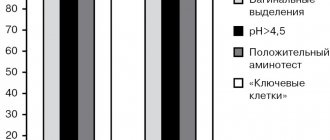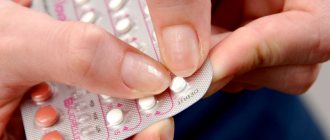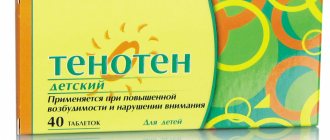Release form and composition
Dosage forms:
- Syrup: light orange, transparent, has a fruity smell (tutti-frutti) and a sweet taste (100 ml in dark glass bottles, 1 bottle in a cardboard box complete with a dosage cap);
- Tablets: flat, round, chamfered, white or grayish-white, on one side there is a line mark, on the other there is an arcuate engraving “PERITOL”, almost odorless or odorless (10 pieces in blisters, 2 blisters in a cardboard pack ).
1 ml of syrup contains:
- Active ingredient: cyproheptadine hydrochloride – 0.4 mg (cyproheptadine hydrochloride sesquihydrate – 0.43 mg);
- Additional components: 96% ethanol, sorbic acid, sucrose, sodium hydroxide, glacial acetic acid, tutti-frutti flavoring agent, sunset yellow dye CI15895 E.110 (ariavit sunset yellow), purified water.
1 tablet contains:
- Active ingredient: cyproheptadine hydrochloride – 4 mg (cyproheptadine hydrochloride sesquihydrate – 4.3 mg);
- Additional components: potato starch, magnesium stearate, talc, gelatin, lactose monohydrate.
Pharmacological properties
Pharmacodynamics
The active component of Peritol, cyproheptadine, is a H1-histamine receptor blocker and has antiserotonin and M-anticholinergic activity. This provides prevention and facilitates the course of allergic reactions. Cyproheptadine is also characterized by sedative, anticholinergic, antiexudative and antipruritic effects.
The drug inhibits the production of ACTH in Ishchenko-Cushing syndrome and the hypersecretion of somatotropin, which is accompanied by acromegaly, and also increases appetite.
Pharmacokinetics
When taken orally, cyproheptadine is quickly and almost completely absorbed from the gastrointestinal tract. Its maximum level in the blood is reached during the first two hours after administration, and the therapeutic concentration is maintained for 4–6 hours. After a single dose of Peritol 4 mg (in the form of tablets or syrup), 2–20% of the substance is excreted through the intestines (of which 34% unchanged, which does not exceed 5.7% of the dose taken). About 40% of the administered dose of the drug is excreted in the urine, mainly in the form of the quaternary ammonium conjugate of cyproheptadine with glucuronic acid.
The excretion of the active component of Peritol in the urine when taken in the form of tablets or syrup does not differ significantly. With long-term use of the drug in daily doses of 12–20 mg, no unchanged substance was detected in the urine of patients. Chronic renal failure leads to decreased excretion of cyproheptadine. Reliable evidence that the compound penetrates the placental barrier or into breast milk has not been found.
Note!
Description of the drug Peritol table. 4mg No. 20 on this page is a simplified author’s version of the apteka911 website, created on the basis of the instructions for use.
Before purchasing or using the drug, you should consult your doctor and read the manufacturer's original instructions (attached to each package of the drug). Information about the drug is provided for informational purposes only and should not be used as a guide to self-medication. Only a doctor can decide to prescribe the drug, as well as determine the dose and methods of its use.
Instructions for use of Peritol: method and dosage
Peritol has a sedative effect, especially at the beginning of treatment, so the first dose of the drug is recommended to be taken after dinner.
Syrup
Recommended dosage regimen for children (daily dose):
- 6-24 months: 0.4 mg/kg;
- 2-6 years: 6 mg (2 mg 3 times a day, maximum 8 mg);
- 7-14 years: 12 mg (4 mg 3 times a day).
Peritol for weight gain (for anorexia) is usually prescribed to children from 6-8 mg per day.
The average adult daily dose is 12 mg (4 mg 3 times a day), the maximum is 32 mg.
Dosage regimen depending on the disease (daily dose):
- Chronic urticaria: 6 mg in 3 divided doses;
- Anorexia: 12 mg in 3 divided doses;
- Acute migraine attacks: 4 mg once. If there is no effect, a single dose can be taken again after 30 minutes. Over 4-6 hours, the total dose of Peritol should not exceed 8 mg.
As a maintenance therapy, 4 mg is usually prescribed 3 times a day.
In case of functional liver disorders, the dose of the drug should be reduced.
Systematic monitoring of the condition of elderly patients during therapy is recommended.
5 ml of syrup corresponds to 2 mg of Peritol.
Pills
Recommended dosage regimen for children (daily dose):
- 2-3 years: 0.25 mg/kg;
- 3-6 years: 4-6 mg in 2-3 doses, maximum – 12 mg; for anorexia – from 6 to 8 (maximum) mg in 3 divided doses;
- 7-14 years: 8-12 mg in 2-3 doses, maximum – 16 mg.
The adult daily dose is usually 12 mg in 3 divided doses.
Dosage regimen depending on the disease (daily dose):
- Chronic urticaria: 1/2 tablet 3 times a day;
- Anorexia: 1 tablet 3 times a day;
- Acute migraine attacks: 1 tablet once. If there is no effect, a single dose can be taken again after 30 minutes. Over 4-6 hours, the total dose of Peritol should not exceed 8 mg.
As a maintenance therapy, 1 tablet is usually prescribed 3 times a day.
Side effects
Syrup
- Cardiovascular system: tachycardia, hypotension;
- Central nervous system: ataxia, drowsiness, headache, visual hallucinations, dizziness, anxiety, tremor;
- Hematopoietic system: leukopenia, hemolytic anemia, agranulocytosis;
- Digestive system: vomiting, nausea, dry mouth, diarrhea;
- Allergic reactions: Quincke's edema, exanthema, urticaria, photosensitivity.
Pills
During therapy, transient drowsiness may develop (in some cases, discontinuation of therapy is required).
Less commonly observed are the development of such adverse reactions as: headache, ataxia, nausea, skin rashes, dry mouth, anxiety, confusion, visual hallucinations, dizziness, agitation.
Indications for use of the drug Peritol
Acute and chronic urticaria, serum sickness, hay fever, vasomotor and allergic rhinitis; allergic reactions that occur when taking medications, exanthema, eczematous, contact dermatitis, neurodermatitis, angioedema, insect bites, carcinoid syndrome, headache of vascular origin (migraine, “histamine” headache). The drug can also be used for anorexia of various origins (anorexia nervosa, idiopathic anorexia), as well as for cachexia (due to an infectious disease, exhaustion, hyperthyroidism).
Overdose
In case of overdose, both depression and stimulation of the central nervous system can occur, sometimes leading to death, especially in infants and children. The main symptoms in pediatric patients include:
- excitation;
- hyperthermia;
- hyperemia of the skin of the face;
- mydriasis and pupillary immobility;
- athetosis;
- hallucinations;
- convulsions;
- vascular collapse;
- coma.
In adults, in this case, psychomotor agitation, convulsions, coma, lethargy, depression, and occasionally skin flushing and hyperthermia are often observed. Gastrointestinal dysfunction and atropine-like effects are possible.
In case of overdose in patients who remain conscious, it is necessary to induce vomiting using ipecac preparations (if it does not occur spontaneously). For patients in a faint state, the stomach is immediately washed with a semi-isotonic or isotonic sodium chloride solution and activated charcoal is subsequently prescribed. For hypotension, vasoconstrictor drugs are used as indicated. Taking analeptics and psychostimulants is contraindicated. It is very important to avoid overdose of Peritol in infants and children.
Side effects of the drug Peritol
CNS: most often - drowsiness, which usually goes away after 3-4 days, sometimes as a result of this it is necessary to stop taking the drug. Other side effects include sedation, dizziness, tinnitus, confusion, incoordination, ataxia, impaired accommodation (mydriasis), double vision, visual hallucinations, anxiety, tremor, irritability, insomnia, paresthesia, neuritis, headache pain, weakness. Allergic reactions: erythema, purpura, urticaria, swelling. In some cases - Quincke's edema and anaphylactic shock. Skin: erythema, skin rashes, photosensitivity. Hematopoietic system: hemolytic anemia, leukopenia, agranulocytosis, thrombocytopenia. Cardiovascular system: hypotension, tachycardia, extrasystole. Respiratory systems: thickening of bronchial secretions, dyspnea, runny nose. Gastrointestinal tract: dry mouth, nausea, vomiting, epigastric discomfort, diarrhea or constipation, cholestasis, hepatitis, jaundice. Urinary system: frequent urge to urinate, difficulty emptying the bladder, urinary retention. Other side effects: while taking the drug Peritol, patients’ body weight often increases.
special instructions
When treating children and elderly patients, special attention is required, since this group of patients is more sensitive to the side effects of antihistamines.
Caution must be observed when prescribing cyproheptadine to patients with cardiovascular diseases, as well as in the presence of anamnestic indications of bronchial asthma, hyperthyroidism or arterial hypertension.
Drinking alcoholic beverages during therapy is contraindicated.
When carrying out complex preoperative preparation of patients, Peritol under the strict supervision of a physician can be used simultaneously with narcotic analgesics, anxiolytics (cyproheptadine potentiates the effect of jointly used drugs and prevents the development of undesirable effects of histamine (in the form of arterial hypotension, bronchospasm), which is released during surgery as a result of tissue trauma organism).
1 tablet contains 128 mg of lactose, which should be taken into account in patients with lactase deficiency, galactosemia or glucose-galactose malabsorption syndrome.
While using Peritol in any dosage form, you should not drive vehicles and equipment, as well as perform work associated with increased risk.
Special instructions for the use of the drug Peritol
Due to the sedative effect of the drug at the beginning of the course of treatment, it is recommended to take the first dose in the evening after the last meal. When using Peritol in weakened or elderly patients, caution should be exercised, as they are more likely to develop side effects (dizziness, drowsiness, hypotension). Caution should be used when treating children as they are more likely to develop side effects such as anxiety. During the initial period of therapy, patients may complain of dizziness and drowsiness. Therefore, at the beginning of the course of treatment with Peritol, it is necessary to refrain from driving vehicles and operating machinery, as well as performing work that requires increased attention. In the future, the degree of this limitation is determined individually. Due to the presence of an anticholinergic effect, caution is recommended when prescribing the drug Peritol for the following conditions:
- BA;
- high intraocular pressure;
- hyperthyroidism;
- cardiovascular diseases;
- AH (arterial hypertension).
Alcohol may enhance the inhibitory effect of antihistamines on central nervous system function (sedation). Therefore, during treatment with Peritol, it is prohibited to drink alcoholic beverages. Long-term use of antihistamines can in some cases cause hematopoietic disorders (leukopenia, agranulocytosis, thrombocytopenia, hemolytic anemia). Therefore, patients with complaints of unexplained fever, sore throat, damage to the oral mucosa, jaundice, ecchymosis, and persistent bleeding should be carefully examined with a hemogram determined. If severe disorders are detected, the need to discontinue the drug should be considered. Peritol syrup contains sucrose. 1 teaspoon (5 ml) contains 2 g, 1 dessert spoon (10 mg) contains 4 g of sucrose. Therefore, the administration of syrup is contraindicated in children with fructose intolerance or impaired absorption of glucose/galactose, as well as sucrose/maltose deficiency. Peritol contains 5% alcohol. 1 teaspoon of syrup (5 ml) contains 0.25 g, and 1 dessert spoon (10 mg) contains 0.5 g of alcohol. The use of Peritol syrup should be prescribed with great caution in case of liver disease, alcoholism, epilepsy, brain injury or other diseases of the central nervous system. Long-term (more than 1 week) use of syrup in children should be carried out only after carefully weighing the benefit/risk ratio. The syrup should be used within 4 weeks after opening the bottle.
Drug interactions
When using certain drugs/substances in combination, the following effects may be observed:
- Fluoxetine and other neuronal serotonin reuptake inhibitors: decreased effectiveness of antidepressants;
- Caffeine, phenamine: reducing the inhibitory effect of cyproheptadine on the central nervous system;
- Ethanol, hypnotics, sedatives, anxiolytics and other substances that depress the central nervous system: additive effect (continuous monitoring of the patient’s condition is required, if necessary, therapy is canceled);
- Monoamine oxidase inhibitors, as well as tricyclic antidepressants: prolongation and enhancement of the m-anticholinergic effect of cyproheptadine and increased inhibitory effects on the central nervous system (combined use with monoamine oxidase inhibitors is contraindicated).
Reviews of Peritol
At the moment, there are both positive and negative reviews about Peritol as an antiallergic drug. It has been proven that cyproheptadine has a strong effect on most body systems and, if the treatment regimen is followed, demonstrates good treatment results, however, an overdose or non-compliance with the rules of administration can lead to undesirable consequences.
In addition, Peritol is used for weight gain. In this case, its use should be combined with the consumption of high-calorie and easily digestible foods, and the possible development of side effects must be taken into account.
It is recommended to take cyproheptadine only as prescribed by a doctor and strictly when indicated. Self-treatment will not only not be successful, but can also cause health problems.
Overdose of the drug Peritol, symptoms and treatment
Symptoms: in children - excessive agitation, anxiety, hallucinations, convulsions. In adults - depression, coma, sometimes psychomotor agitation, convulsions. Treatment: gastric lavage, use of activated carbon; with the development of pronounced atropine-like effects - parenteral administration of physostigmine salicylate solution; according to indications - vasoconstrictor and anticonvulsants. Artificial ventilation and other resuscitation measures.



